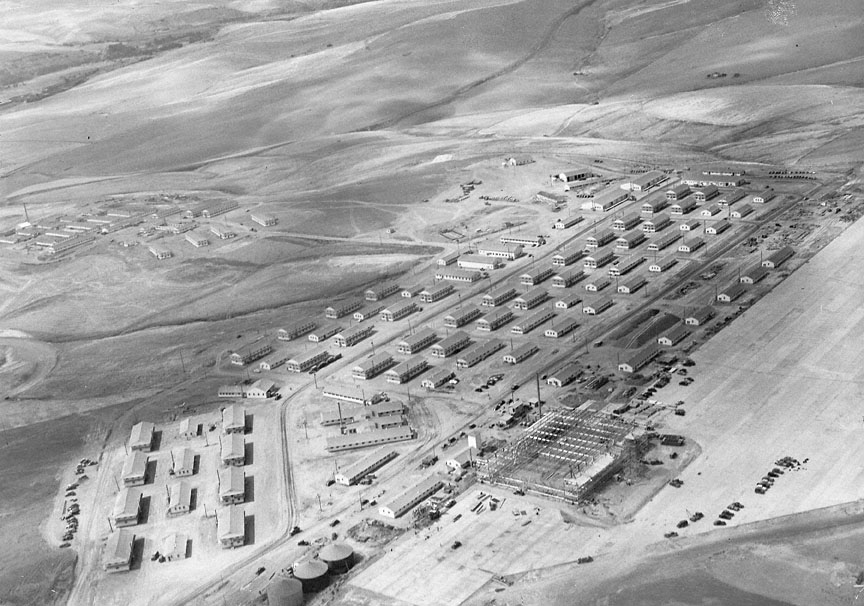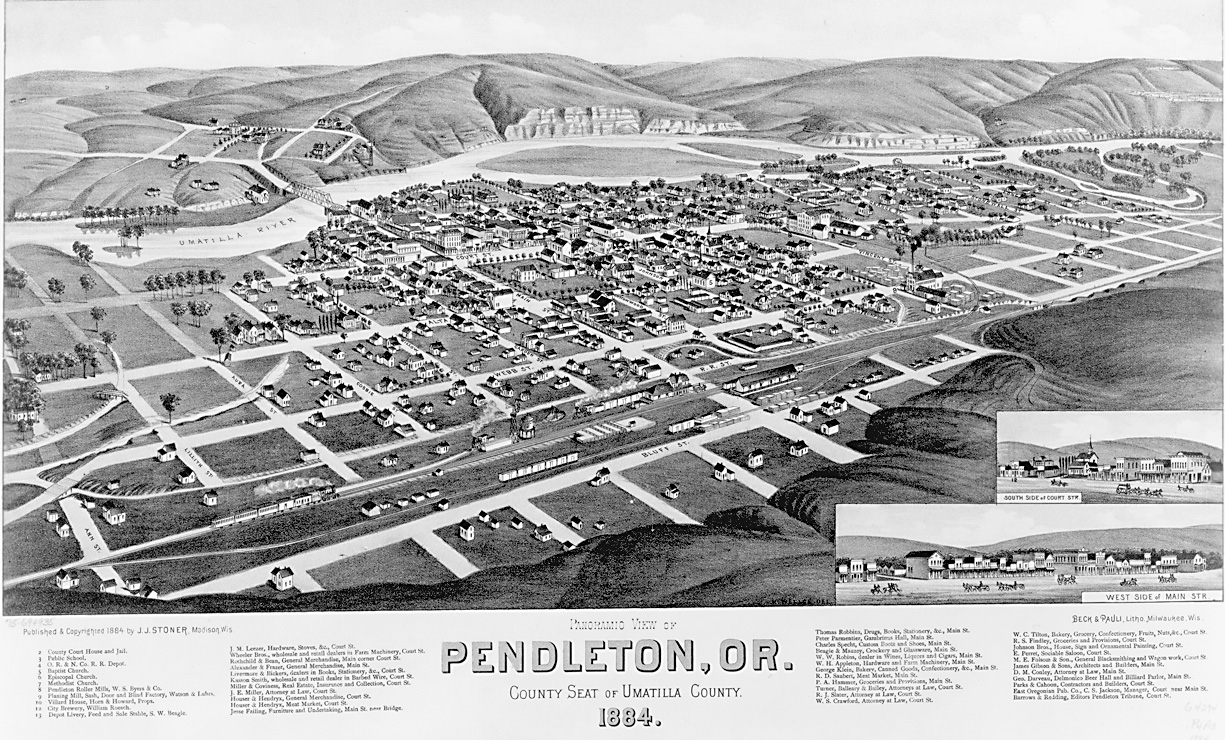On November 29, 1940, the War Department announced that Pendleton, Oregon, had been selected as a site for an Army Air Corps station for training combat crews in the Northwest Air District, under the jurisdiction of the 2nd Air Force. Pendleton had a municipal airport with United Air Lines service and was strategically located along major railways and highways.
The War Department allocated nearly $1.6 million for construction of the airbase. The city acquired the land by December, and leases were signed with the War Department in the spring. In March, the state agreed to build a new roadway to the base. W.C. Smith & Co. of Duluth, Minnesota, was awarded the contract for the construction of 122 structures, and E.C. Gerber of Oregon City was contracted to expand and build the runways.
Construction, supervised by the Corps of Engineers, began soon after the groundbreaking ceremony on February 16, 1941. Col. Frank Wright arrived in early March to assume command and begin preparing for the three thousand officers and enlisted personnel who would be stationed at the base. The first enlisted men, a unit of the 254th Quartermaster Corps, arrived on April 15. With the arrival in June of over five hundred men of the 19th Air Base Group and units of the 17th Bombardment Group and the 89th Reconnaissance Squadron, the base reached its authorized strength of 303 officers and 2,218 enlisted men.
In July, the War Department designated the airbase Pendleton Field in honor of Senator George Hunt Pendleton (1825-1889) of Ohio, for whom the City of Pendleton had also been named. Most of the buildings on the base were finished by August. The Pendleton Housing Corporation, a group of Pendleton citizens, raised $100,000 to build a hundred houses for officers, and the federal government provided $400,000 to build eighty-five housing units for noncommissioned officers and civilian employees.
In November 1941, fourteen North American B-25 bombers arrived at Pendleton Field. In December, planes from Pendleton Field flew antisubmarine patrols along coastal areas as part of the 2nd Air Force air defense for the Northwest Pacific coastline. In January 1942, the 2nd Air Force was relieved from the defense of the coast, and Pendleton Field was assigned the task of providing heavy bombardment unit training. Pendleton Field was assigned because it was one of four bases with runways long enough to fulfill the training requirements. In February, the B-25-equipped 17th Bombardment Group at Pendleton Field was reassigned to Columbia Army Air Base, South Carolina, where Lt. Col. Jimmy Doolittle formed volunteer crews to train for the Doolittle Raid against Japan on April 18. Of the eighty Raiders, all but Doolittle had trained at Pendleton Field.
In February, Colonel Wright announced that a hundred civilian workers would be enlisted for Air Corps duty. Within a month, planes were flying around the clock in the training program. In September 1942, Pendleton Field was placed under the 4th Air Service Command, with headquarters in Sacramento. The 330th Service Group, which engaged in supply and maintenance training on aircraft, was assigned to Pendleton Field.
Over a hundred planes that flew from Pendleton Field crashed during the war. In the summer of 1943, four B-17 heavy bombers, known as the Flying Fortress, crashed; twenty-seven crewmembers died and six survived. By late 1943, the Army Air Corps, now called the Army Air Forces, reached the peak of its activity in the continental United States with the highest number of separate installations during the war.
In January 1944, the work of military airbases switched from training and equipping the air forces to supply and maintenance operations, resulting in dramatic cutbacks. Pendleton Field was among sixty-nine bases placed on standby status during this reorganization. In March, Pendleton Field was reactivated as a sub-base of Walla Walla Field under the 4th Air Force, which provided final training for P-38 and Night Fighter Squadrons and B-24 heavy bomber units. In mid-April, six A-23 tow planes arrived with a Tow-Target Squadron. By December 1944, active units at Pendleton Field had been transferred and the airfield was designated inactive.
Pendleton Field was reactivated in May 1945, and from May to October, the 555th Parachute Infantry Battalion, known as the Triple Nickles, was stationed at the airfield to fight forest fires, particularly those ignited by Japanese balloons carrying incendiary bombs. Known as Smoke Jumpers, the Triple Nickles was an all-Black infantry unit comprised of the nation’s first military airborne firefighters. During fire operations, the battalion suffered numerous injuries but only one fatality.
In November 1945, Pendleton Field was one of the eleven military airfields in Oregon declared surplus property. The Instrument of Transfer of the base to the City of Pendleton was signed July 13, 1948, and the buildings and hangar that remain are managed by the city. The Pendleton Field runways are now part of the Eastern Oregon Regional Airport, which is also the location of the Pendleton Army Aviation Support Facility, home station for Chinook helicopter units of the Oregon Army National Guard.
-
![]()
Pendleton Field, 1941.
Courtesy Oregon Hist. Soc. Research Lib., OrHi71475
Related Entries
-
![Pendleton]()
Pendleton
Pendleton, a city of 17,107 in the 2020 census, sits in the foothills o…
-
![Triple Nickles -- 555th Parachute Infantry Battalion]()
Triple Nickles -- 555th Parachute Infantry Battalion
The 555th Parachute Infantry Battalion, nicknamed the "Triple Nickles" …
-
![Umatilla Army Depot]()
Umatilla Army Depot
In 1940, the U.S. Army identified twenty thousand acres straddling the …
Related Historical Records
Map This on the Oregon History WayFinder
The Oregon History Wayfinder is an interactive map that identifies significant places, people, and events in Oregon history.
Further Reading
Mauer, Mauer, ed. "Air Force Combat Units of World War II." Washington, DC: Office of Air Force History, 1983.
Macnab, Gordon. A Century of News and People in the East Oregonian, 1875–1975. Pendleton, Ore: East Oregonian Publishing Co., 1975.
“World War II Commemorative Issue” Pioneer Trails 15.1 (Spring/Summer 1991).




